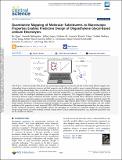Quantitative Mapping of Molecular Substituents to Macroscopic Properties Enables Predictive Design of Oligoethylene Glycol-Based Lithium Electrolytes
Author(s)
Qiao, Bo; Mohapatra, Somesh; Lopez, Jeffrey Frank; Leverick, Graham M.; Tatara, Ryoichi; Shibuya, Yoshiki; Jiang, Yivan; France-Lanord, Arthur; Grossman, Jeffrey C.; Gómez-Bombarelli, Rafael; Johnson, Jeremiah A.; Shao-Horn, Yang; ... Show more Show less
DownloadPublished version (5.368Mb)
Publisher Policy
Publisher Policy
Article is made available in accordance with the publisher's policy and may be subject to US copyright law. Please refer to the publisher's site for terms of use.
Terms of use
Metadata
Show full item recordAbstract
Molecular details often dictate the macroscopic properties of materials, yet due to their vastly different length scales, relationships between molecular structure and bulk properties can be difficult to predict a priori, requiring Edisonian optimizations and preventing rational design. Here, we introduce an easy-to-execute strategy based on linear free energy relationships (LFERs) that enables quantitative correlation and prediction of how molecular modifications, i.e., substituents, impact the ensemble properties of materials. First, we developed substituent parameters based on inexpensive, DFT-computed energetics of elementary pairwise interactions between a given substituent and other constant components of the material. These substituent parameters were then used as inputs to regression analyses of experimentally measured bulk properties, generating a predictive statistical model. We applied this approach to a widely studied class of electrolyte materials: oligo-ethylene glycol (OEG)-LiTFSI mixtures; the resulting model enables elucidation of fundamental physical principles that govern the properties of these electrolytes and also enables prediction of the properties of novel, improved OEG-LiTFSI-based electrolytes. The framework presented here for using context-specific substituent parameters will potentially enhance the throughput of screening new molecular designs for next-generation energy storage devices and other materials-oriented contexts where classical substituent parameters (e.g., Hammett parameters) may not be available or effective.
Date issued
2020-06Department
Massachusetts Institute of Technology. Department of Chemical Engineering; Massachusetts Institute of Technology. Department of Materials Science and Engineering; Massachusetts Institute of Technology. Research Laboratory of ElectronicsJournal
ACS Central Science
Publisher
American Chemical Society (ACS)
Citation
Qiao, Bo et al. "Quantitative Mapping of Molecular Substituents to Macroscopic Properties Enables Predictive Design of Oligoethylene Glycol-Based Lithium Electrolytes." ACS Central Science 6, 7 (June 2020): 1115–1128 © 2020 American Chemical Society
Version: Final published version
ISSN
2374-7943
2374-7951